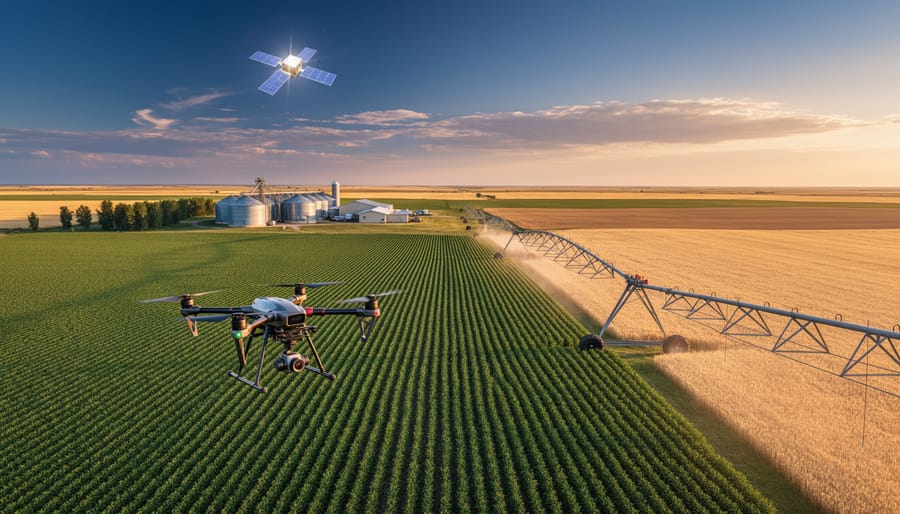Monitor soil moisture levels regularly to optimize irrigation scheduling and prevent over- or under-watering crops. Improve water infiltration by maintaining soil organic matter, minimizing tillage, and using cover crops to enhance soil structure. Implement efficient irrigation systems like drip or micro-sprinklers to deliver water directly to plant roots, reducing evaporation and runoff losses. Collect and store rainwater or runoff in ponds or cisterns for use during dry periods, supplementing irrigation supplies and conserving groundwater resources.
Maximizing Irrigation Efficiency

Case Study: Alberta Farm Cuts Water Usage by 30%
In a remarkable example of water conservation, an Alberta farmer has successfully reduced water usage on their farm by an impressive 30%. By implementing a combination of precision irrigation techniques, such as drip irrigation and soil moisture monitoring, they were able to optimize water application based on crop requirements and weather conditions.
The farmer also invested in advanced technologies like variable rate irrigation systems, which adjust water output according to specific areas of the field. This targeted approach minimizes water waste and ensures that each plant receives the optimal amount of moisture for growth.
Furthermore, the farm adopted conservation tillage practices, such as no-till and cover cropping, to improve soil structure and water retention capacity. These methods help to reduce evaporation and runoff, allowing more water to be available for crop uptake.
The success of this Alberta farm demonstrates the significant impact that efficient water management practices can have on agricultural sustainability. By embracing innovative technologies and soil conservation techniques, farmers can substantially reduce their water footprint while maintaining or even improving crop yields. This case study serves as an inspiring example for other farmers in the region, showcasing the potential for water savings and the benefits of adopting sustainable irrigation practices.

Preventing Nutrient Runoff and Leaching
Creating Nutrient Management Plans
Creating a customized nutrient management plan is essential for optimizing water and nutrient application in your fields. Start by gathering data on your soil type, crop requirements, and current irrigation practices. Conduct soil tests to determine nutrient levels and identify any deficiencies or imbalances. Use this information to calculate the precise amounts of water and nutrients needed for each growth stage of your crops.
Next, consider the timing of application. Align irrigation schedules with critical growth stages to ensure plants receive the right resources when they need them most. Incorporate weather forecasts and moisture sensors to adjust water delivery based on real-time conditions. By syncing nutrient application with irrigation, you can improve uptake efficiency and minimize runoff.
Choose the most suitable application methods for your farm, such as drip irrigation, fertigation, or foliar sprays. Regularly monitor and record your water and nutrient inputs to track progress and make data-driven adjustments. Collaborate with local agronomists or extension services to refine your plan based on the latest research and best practices.
Remember, a well-designed nutrient management plan not only enhances crop health and yields but also protects water resources by reducing leaching and waste. By investing time in creating a customized plan, you contribute to the long-term sustainability and profitability of your farm while being a responsible steward of our shared environment.
Enhancing Soil Health with Smart Watering
Smart watering practices not only conserve this precious resource but also contribute to the health and vitality of agricultural soils. By optimizing irrigation schedules and techniques, farmers can foster an environment that promotes beneficial microbial activity and improves soil structure.
Soil microorganisms play a crucial role in nutrient cycling, disease suppression, and overall soil health. However, these tiny allies thrive best in well-aerated soils with balanced moisture levels. Overwatering can lead to waterlogged conditions that deprive soil of oxygen, while underwatering can cause microbes to become dormant or die off. By implementing smart watering strategies, such as drip irrigation or soil moisture monitoring, farmers can maintain the ideal conditions for microbial communities to flourish.
Moreover, optimized irrigation contributes to better soil structure. When water is applied in a controlled and efficient manner, it helps maintain soil aggregates—clumps of soil particles bound together by organic matter and microbial secretions. These aggregates create a network of pores that allow for proper water infiltration, drainage, and root growth. In contrast, excessive or irregular watering can cause soil compaction, crusting, and erosion, all of which degrade soil structure over time.
Alberta farmers have seen the benefits of smart watering firsthand. For example, John Smith, a grain farmer near Edmonton, adopted variable rate irrigation technology on his fields. “By applying water precisely where and when it’s needed, I’ve noticed improvements in soil tilth and fertility,” he shares. “The soil feels more alive and my crops are thriving.”
Local agricultural organizations, such as the Alberta Irrigation Projects Association, offer resources and training to help farmers implement best practices for water management and soil health. By working together as a community, Alberta farmers can safeguard their soil resources while optimizing water use efficiency on their operations.

Adapting to Climate Change
Investing in Water Storage Infrastructure
Investing in water storage infrastructure is a proactive step that can significantly enhance agricultural water management in the Alberta region. By implementing solutions such as reservoirs and retention ponds, farmers can capture and store excess water during periods of high rainfall or snowmelt. This stored water becomes an invaluable resource during dry spells or times of increased irrigation demand. Not only does this help ensure a consistent water supply for crops, but it also reduces the strain on local water sources and minimizes the risk of water shortages.
Moreover, well-designed water storage systems can help mitigate the impact of extreme weather events, such as floods or droughts, which are becoming more frequent due to climate change. By having a readily available water source, farmers can maintain crop health and yields even during challenging conditions. Additionally, stored water can be used for other agricultural purposes, such as livestock watering or cleaning equipment, further optimizing overall water usage on the farm.
Investing in water storage infrastructure is a smart long-term strategy that contributes to the sustainability and resilience of Alberta’s agricultural sector. By taking control of their water resources, farmers can adapt to changing weather patterns, reduce their environmental footprint, and ensure the continued success of their operations for generations to come.
Resources and Support for Alberta Farmers
Alberta farmers looking to optimize their water management practices and improve sustainability can access a wealth of resources and support through the Organic Farming, The Canadian Way initiative. This program offers a range of workshops designed to provide hands-on training and practical insights into water conservation techniques, irrigation efficiency, and soil health management. Experienced instructors guide participants through best practices and innovative solutions tailored to the unique challenges faced by Alberta’s agricultural community.
In addition to educational opportunities, the initiative provides grant funding to support the implementation of water-smart technologies and infrastructure on Alberta farms. These grants can help offset the costs associated with installing precision irrigation systems, constructing water storage facilities, or adopting other water-saving measures. By leveraging these financial resources, farmers can make meaningful investments in their operations while reducing their environmental impact.
Expert advice is also readily available through the program’s network of agricultural specialists and mentors. These knowledgeable professionals offer one-on-one consultations to help farmers develop customized water management strategies that align with their specific goals and site conditions. Whether you’re seeking guidance on crop selection, irrigation scheduling, or erosion control, these experts can provide the insights and support you need to make informed decisions and achieve long-term success.
By participating in the Organic Farming, The Canadian Way initiative, Alberta farmers become part of a vibrant community dedicated to advancing sustainable agriculture practices. Through shared learning experiences, collaborative problem-solving, and a commitment to environmental stewardship, this community is working together to build a more resilient and prosperous future for Alberta’s agricultural sector.
In conclusion, implementing smart agricultural water management practices can have a profound impact on farm profitability and environmental stewardship in Alberta and beyond. By adopting strategies such as precision irrigation, soil moisture monitoring, and water-efficient crop selection, farmers can optimize their water usage, reduce costs, and improve yields. Moreover, these practices contribute to the long-term sustainability of our agricultural landscape, preserving precious water resources for future generations. As we face the challenges of climate change and increasing global food demand, it is crucial that we prioritize responsible water management in agriculture. By working together as a community, sharing knowledge, and embracing innovation, we can create a more resilient and prosperous farming sector that benefits both our economy and our environment. The future of agriculture depends on our collective commitment to sustainable practices, and smart water management is a key piece of that puzzle.











